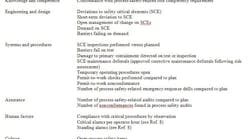When driving down the road, we glance in the rearview mirror to see what’s happening behind us — but the majority of the time we concentrate on what’s in front of us. However, when it comes to process safety metrics, we still focus on the lag metrics, what happened yesterday, rather than the lead metrics, information that can help us manage our future. This is like driving while mostly looking in the rearview mirror. At some point, our not observing information in front of us may lead to an accident.
In the early 2000s, the Center for Chemical Process Safety (CCPS) [1] and the American Petroleum Institute [2] worked to achieve some commonality in process safety metrics. This led to clearly defined lagging metrics, which we now call Tier 1 and Tier 2 losses of containment. The two groups then developed some options for leading metrics, known as Tier 3 and Tier 4. Additionally in 2010, CCPS published the results of a survey of leading indicators used by industry [3].
[callToAction ]
Following on from this work, the members of the IChemE Safety Centre (ISC) launched a project to fully define a suite of leading process safety metrics. Defining the metrics in detail would enable benchmarking on the leading side of safety, not just the lagging side. This project culminated in a published guidance document titled “Lead Process Safety Metrics — Selecting, Tracking and Learning” [4]. (Get a free copy.) A number of companies contributed to this document. I particularly would like to acknowledge: Quadrant Energy, EnVizTec, MMI Engineering, Orica, Simon Casey Risk and Safety Consultant, Todd Corporation, and Woodside.
Table 1. Each functional safety element has at least one lead metric.
Several prominent process safety incidents, such as the 2005 explosion at BP’s Texas City, Texas, refinery, have underscored the need for operating companies to track and understand process safety metrics just as they do occupational safety ones. Indeed, the tracking of process safety metrics is vital to help us understand the state of our facilities and systems — and to alert us to impending issues. Importantly, while lagging process safety metrics enable us to compare current to historical data to monitor improvement, they won’t necessarily predict future loss-of-control events. In contrast, leading metrics are proactive and afford the opportunity to manage potential safety issues. However, lead metrics of course aren’t an absolute predictor of process safety.
The ISC project started with reviewing the lead metrics reported by each member company to look for commonality. Then, the team winnowed these metrics based on their apparent value for driving decisions or actions in the organization. Recording and analyzing data takes time and resources. If the data analysis doesn’t result in useful decisions or actions, it’s a wasted effort. The team next undertook a second screening based on “ease of collection” to further identify the most important metrics and reduce the list to a manageable number.
A Dual Approach
Lead metrics fall into two types. The first identifies positive situations, such as work being completed to schedule. This is related to the concept of “Safety-II” [5] where the focus is on understanding how a thing goes right in a quest to replicate it, as opposed to understanding how a thing goes wrong in a quest to prevent reoccurrence. The premise is that things go right far more often, so there’s a greater source of information to learn from. The focus for this metric is to trend toward 100% compliance. However, achieving 100% isn’t reason to relax but instead cause to explore whether the metric is accurate and not misleading about the health of the system.
The second type of lead metric is akin to holes forming in the so-called Swiss cheese barriers [6]. This metric measures failure of a barrier — so for it to be considered a lead metric, other barriers must have prevented the consequence from occurring. It can be thought of as a measure of the barrier’s weakness. The focus of this metric is to drive the failure toward zero. However, a zero or very low result should prompt analysis to ensure the metric is accurate.
In a nutshell, the first type looks for barriers being present and strong while the second type looks for weaknesses in barriers. A balance between these two types of metrics is important.
It’s essential to understand the similarities and differences between barriers, primary containment and safety critical elements. In defining common lead metrics, the team made a number of assumptions regarding how a facility or organization has defined these items. However, each organization must define them for itself on the basis of the major incidents that are to be prevented. For example, when a metric refers to the integrity of barriers or primary containment, the items covered should serve as a final defense against a major incident.
Organizations vary in how they define barriers; this hampers defining standard guidelines on barriers. The team chose the term safety critical element (SCE) to simplify the discussion. An SCE can be either a hardware or administrative barrier that has been determined as being critical in preventing or mitigating a major incident. Some SCEs will be passive, such as fireproofing, and some will be active, such as an emergency shutdown system. Different types of barriers require different management. For this reason, it’s crucial to understand what types of barriers you have in place.
When analyzing individual lead metrics, you also should view each in the broader context of all lead metrics. This allows insight into whether the metrics are providing the same story about the health of the systems. If leading metrics don’t complement each other as expected, some underlying issues may need resolution. Additionally, if after a period of time, dependent on the metric, leading metrics are showing great improvement but lagging metrics aren’t, you should revisit the metrics and analysis to determine whether the leading metrics are assisting the organization. Different leading metrics may be necessary to drive different outcomes.
Six Key Elements
The ISC believes effective management of process safety requires leadership across six functional elements in an organization [7]:
• knowledge and competence;
• engineering and design;
• systems and procedures;
• assurance;
• human factors; and
• culture.
Figure 1. Leadership across six functional elements underpins effectiveness.
You can think of these elements, shown in Figure 1, as a chain of safety rather than application of Reason’s Swiss cheese model [5]. This is because we don’t need failures in all elements to have an incident — instead single or multiple failures in one element could result in an event. The integrity of the chain depends upon the multiple layers behind it; hence, at least one metric in the guidance document monitors the health of each element.
When considering the metrics, it was important to define multiple aspects of them, such as their purpose, how they could be implemented, what types of decisions the data should support, and how they can be consolidated for high level reporting.
Each metric was selected solely on its merit. Only later were the metrics assigned by consensus to elements; at that stage it was found that each element had at least one metric. Table 1 lists the metrics with their corresponding element.
Where Do We go From Here?
Defining leading process safety metrics is a challenging task for any organization. While the majority of available guidance states that each facility must develop its own metrics based on individual needs, a comprehensive review of the ISC member companies showed commonality in leading metrics. This enabled us to publish a consolidated guidance document.
The ISC currently is working to develop practical toolkits to help companies implement the metrics consistently. This then will allow benchmarking of lead process safety metrics. The ISC intends to provide this benchmarking service to its members in 2017 and possibly more broadly in the following months.
The ISC believes that shining a light on process safety will spur better safety outcomes as companies strive to improve. It’s time to be part of the future of process safety.
Learn More
The IChemE Safety Centre (ISC) is an industry-funded and -led consortium that focuses on improving process safety through the sharing of information and learnings. Its advisory board defines a specific need based on member inputs — and selected lead process safety metrics as an initial area of work. The ISC appoints a project sponsor who assembles a team made up of personnel from member companies. For more information, go to www.ichemesafetycentre.org.
TRISH KERIN is director of the IChemE Safety Centre, Melbourne, Australia. E-mail her at [email protected].
REFERENCES
1. “Process Safety Leading and Lagging Metrics,” Center for Chemical Process Safety, New York City (2007).
2. “Recommended Practice 754: Process Safety Performance Indicators for the Refining and Petrochemical Industries,” American Petroleum Institute, Washington, D.C. (2010).
3. “Process Safety Leading Indicators Industry Survey,” Center for Chemical Process Safety, New York City (2010).
4. “Lead Process Safety Metrics — Selecting, Tracking and Learning,” IChemE Safety Centre, Melbourne, Australia (2015).
5. Hollnagle, E., “Safety-I and Safety-II: The Past and Future of Safety Management,” Ashgate Publishing, Aldershot, U.K. (2014).
6. Reason, J., “Managing the Risks of Organisational Accidents,” Ashgate Publishing, Aldershot, U.K. (1997).
7. “Process Safety and the ISC,” IChemE Safety Centre, Melbourne, Australia (2014).
8. “ Publication 191: Alarm Systems — A Guide to Design, Management and Procurement,” Eng’g. Equip. & Materials Users Assn., London (1999).



